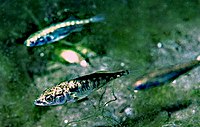
Photo from wikipedia
Background and Aims Under a widely accepted model of pollinator-driven speciation, geographic variation in pollinator assemblage drives floral divergence and automatically causes reproductive isolation. Yet it is unclear whether divergent… Click to show full abstract
Background and Aims Under a widely accepted model of pollinator-driven speciation, geographic variation in pollinator assemblage drives floral divergence and automatically causes reproductive isolation. Yet it is unclear whether divergent floral adaptation initially confers strong reproductive isolation, or whether that comes at later stages of speciation and requires other forms of reproductive isolation. This study uses a pair of recently diverged, interfertile and parapatric species in the genus Clarkia to determine whether adaptation to hawkmoths, a novel pollinator functional group, would automatically confer floral isolation upon sympatric contact. Methods First, genetically based differences in floral traits between C. breweri and C. concinna that would be maintained upon migration are quantified. Then scenarios of experimental sympatry are constructed in which arrays of flowers are exposed to the novel pollinator, the hawkmoth Hyles lineata, and pollinator preference and heterospecific pollen transfer are assessed. Source populations from across the ranges of each species are used to understand how geographic variation in floral traits within species may affect floral isolation. Key Results Although H. lineata has never been observed visiting C. concinna in the wild, it regularly moves between species in experimental floral arrays. Hawkmoth preference and heterospecific pollen transfer vary both among moths and among geographic source locations of C. concinna. The strength of floral isolation in this system is related to variation in flower size, especially hypanthium tube width, and nectar reward among C. concinna forms. Conclusions Although C. breweri has adopted a novel hawkmoth pollination system, both ethological and mechanical floral isolation by hawkmoths are incomplete and vary according to the specific phenotype of the C. concinna source population. The results suggest that strong floral isolation is not automatically conferred by a pollinator shift and may require additional evolution of deterrent floral traits and habitat isolation that reduces the immediate spatial co-occurrence of young species.
Journal Title: Annals of Botany
Year Published: 2019
Link to full text (if available)
Share on Social Media: Sign Up to like & get
recommendations!